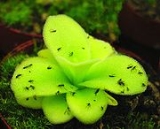
Pinguicula gigantea
Encyclopedia
Pinguicula gigantea is a tropical species of carnivorous plant
in the family Lentibulariaceae
. Its native range is within Mexico. P. gigantea's flower is usually a purple
colour with the occasional light blue also seen. P. gigantea
was once classified as Pinguicula ayautla.
This Pinguicula
was discovered by Alfred Lau and described by the botanist Hans Luhrs.
P. gigantea has a few different forms, such as the 'white flower' form or the 'blue flower'.
at an altitude of 688 meters or 2260 feet.
s on them, which secrete a mucilage
that traps prey. P. gigantea's leaves are among the largest in its genus. The species epithet, gigantea, describes this characteristic.
where this Pinguicula species lives. In order to survive in these conditions it forms non-carnivorous leaves and can handle dry conditions. When the plant emerges from its dormant period in the Spring, it produces new carnivorous leaves and eventually flowers.
Carnivorous plant
Carnivorous plants are plants that derive some or most of their nutrients from trapping and consuming animals or protozoans, typically insects and other arthropods. Carnivorous plants appear adapted to grow in places where the soil is thin or poor in nutrients, especially nitrogen, such as acidic...
in the family Lentibulariaceae
Lentibulariaceae
Lentibulariaceae is a family of carnivorous plants containing three genera, Genlisea, the corkscrew plants, Pinguicula, the butterworts, and Utricularia, the bladderworts....
. Its native range is within Mexico. P. gigantea
Purple
Purple is a range of hues of color occurring between red and blue, and is classified as a secondary color as the colors are required to create the shade....
colour with the occasional light blue also seen. P. gigantea
was once classified as Pinguicula ayautla.
This Pinguicula
Pinguicula
The butterworts are a group of carnivorous plants comprising the genus Pinguicula. Members of this genus use sticky, glandular leaves to lure, trap, and digest insects in order to supplement the poor mineral nutrition they obtain from the environments. Of the roughly 80 currently known species, 12...
was discovered by Alfred Lau and described by the botanist Hans Luhrs.
P. gigantea has a few different forms, such as the 'white flower' form or the 'blue flower'.
Habitat
P. gigantea grows in the Mexican state of OaxacaOaxaca
Oaxaca , , officially Estado Libre y Soberano de Oaxaca is one of the 31 states which, along with the Federal District, comprise the 32 federative entities of Mexico. It is divided into 571 municipalities; of which 418 are governed by the system of customs and traditions...
at an altitude of 688 meters or 2260 feet.
Leaves and carnivory
P. gigantea, unlike most Pinguicula species, has sticky upper and undersides of the leaves. The leaves have trichomeTrichome
Trichomes are fine outgrowths or appendages on plants and certain protists. These are of diverse structure and function. Examples are hairs, glandular hairs, scales, and papillae.- Algal trichomes :...
s on them, which secrete a mucilage
Mucilage
Mucilage is a thick, gluey substance produced by most plants and some microorganisms. It is a polar glycoprotein and an exopolysaccharide.It occurs in various parts of nearly all classes of plant, usually in relatively small percentages, and is frequently associated with other substances, such as...
that traps prey. P. gigantea
Flowers
The flowers of P. gigantea are usually zygomorphic. The varieties of P. gigantea differ solely on their flowers, such as the 'blue flower' P. gigantea or the 'white flower' forms. Other forms have also been described.Dormancy and winter
P. gigantea is a tropical Mexican species of Pinguicula. Its dormancy is not regulated by temperature or light. Like most tropical species, its dormancy is triggered by lack of moisture. Very little precipitation falls during the winter in MexicoMexico
The United Mexican States , commonly known as Mexico , is a federal constitutional republic in North America. It is bordered on the north by the United States; on the south and west by the Pacific Ocean; on the southeast by Guatemala, Belize, and the Caribbean Sea; and on the east by the Gulf of...
where this Pinguicula species lives. In order to survive in these conditions it forms non-carnivorous leaves and can handle dry conditions. When the plant emerges from its dormant period in the Spring, it produces new carnivorous leaves and eventually flowers.

